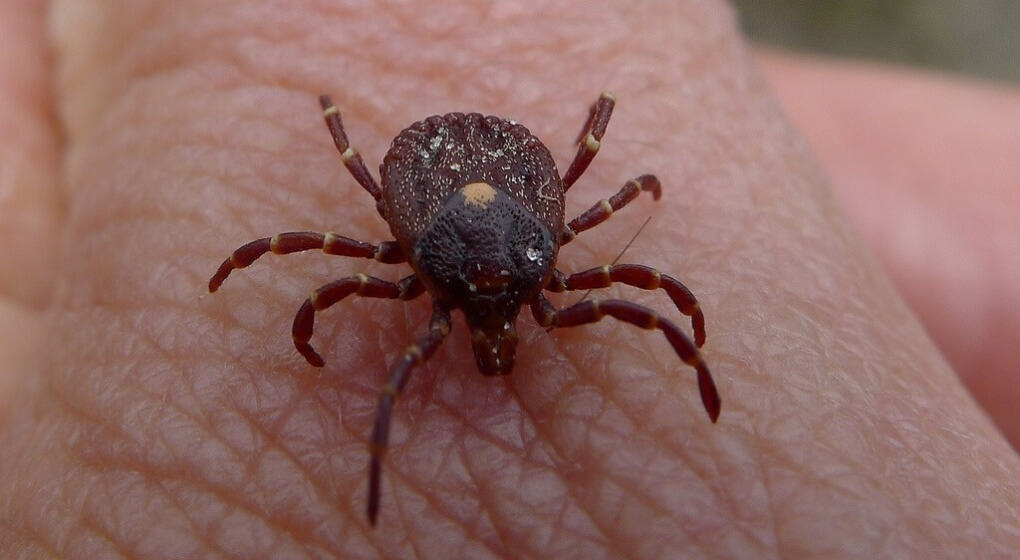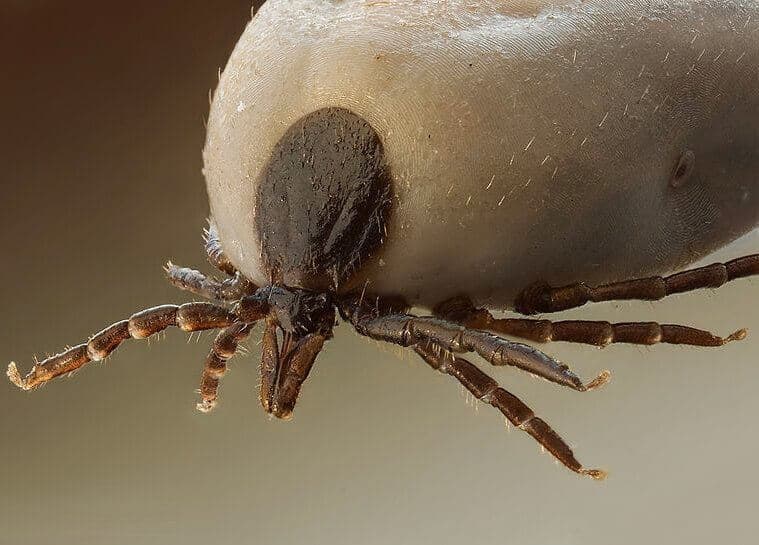
Lyme disease is caused by a bite from a tick which is infected with Borrelia burgdorferi bacteria. The deer tick is the most well-known carrier of Lyme disease but the bacteria may be carried by Western black-legged ticks as well. There are at least 30,000 confirmed Lyme infection cases in the US each year. See the infographic below for some basic stats.
Prefer video to text?
Lyme Disease Infographic:

Lyme disease is a progressive illness occurring in three stages, and ending in a fourth, chronic phase. Progression through the stages of Lyme disease in humans can take a number of months or in some cases, years. Many people with Lyme disease are unaware that they have the infection in the early stages.
Stage 1 Lyme Disease
Symptoms of Lyme disease may begin a few days or weeks after infection. In many cases, you may not know that you have been bitten as ticks that carry Lyme disease are very small and their bites painless.
Stage 1 Lyme Disease Symptoms
Stage 1 is also called “early localized Lyme disease” and may last for 1 to 4 weeks. You may have symptoms including:
- A circular rash that may expand over time (erythema migrans), which may also have a bulls-eye appearance
- Flu-like symptoms, such as:
- Fever
- Chills
- Joint and muscle pain
- Stiff neck and headache
- Fatigue
- General feeling of illness
- Swollen lymph glands
Symptoms of stage 1 Lyme disease may not always be present. In some cases, Lyme disease symptoms may come and go.
The rash that occurs with Lyme disease at the site of the tick bite is typically present in fewer than 50% of cases. The rash itself is not usually itchy or be painful but may be warm to the touch. In people with light colored skin, the rash may appear to be pink or red, those with darker skin may have a rash that looks more like a bruise.

Source: Flickr Creative Commons
In most cases, the rash will go away in four weeks but other symptoms may persist or get worse. They often also go dormant for a while, only to emerge later in more severe ways. If Lyme disease is not treated during this stage, it will go on to stage 2 which can affect other areas of the body.
Stage 1 Lyme Disease Treatment
Lyme disease may be treated during stage 1 with a course of antibiotics such as:
- Doxycycline
- Cefuroxime
- Amoxicillin
Unfortunately, unless the tick bite was documented with the tick being positively identified and a rash is clearly present, it is difficult to confirm Lyme disease and physicians who are not Lyme-literate may be hesitant to prescribe treatment. Often acute cases resemble a "flu-like illness" potentially with a localized rash which may or may not be in a bullseye shape. Known laboratory testing for Lyme disease relies on antibody production which may not occur until several weeks after infection.
In some rare cases, a single dose of doxycycline may be used if all of the following requirements have been met:
- A tick is attached to the body or has been removed and can be identified
- The tick was attached to the body for more than 36 hours
- Medication can be started within 72 hours of tick removal
- More than 20 percent of ticks in the area are known to carry the bacteria Borrelia burgdorferi
- The patient is over 8 years of age and not pregnant or breastfeeding

Dr. Eric Wood, ND
The Naturopathic Doctor says...
"Clinically, I wouldn’t be comfortable prescribing such a short course. Evidence suggests ticks can transmit within four hours of a bite and the life cycle of the disease is long--nearly four weeks. If a patient has been infected and given just a single dose, odds are high it won’t kill everything, leaving a false sense of 'clearance' and potentially a latent, brewing infection."
Stage 2 Lyme Disease
The second stage of Lyme disease is called Early Disseminated Lyme Disease. It may occur weeks to months after infection. Stage 2 symptoms can range from mild to severe – or you may not notice them at all. A strange disease indeed.
Stage 2 Lyme Disease Symptoms
Symptoms of Stage 2 Lyme disease may include:
- Flu-like symptoms - similar to or worse than those in Stage 1
- Fever, chills, joint and muscle pain, stiff neck and headache
- Swollen lymph nodes or glands
- Fatigue
- Sore throat
- Visual disturbances such as blurry vision
- Paralysis or weakness in the face
- Pain or numbness in the bite area
- Heart palpitations
As with stage 1, not everyone with stage 2 Lyme disease will have notable symptoms. In some cases, the disease is obvious but in other cases you may feel completely well regardless of how severe the stage 1 symptoms were.
Stage 2 Lyme Disease Treatment
Lyme disease infection may be confirmed by laboratory testing which detects antibodies in the bloodstream but not all patients with Lyme will test positive for the infection and without positive laboratory confirmation, many physicians will be reluctant to prescribe treatment. There are now many other testing methodologies that are utilized besides just antibody testing, which in combination make this testing more accurate and reliable. The better labs use ELISA, PCR, antibodies and possibly more all in one combined profile.

Source: Flickr Creative Commons
If treatment is prescribed, antibiotic treatment for Lyme disease during stage 2 usually involves a course of oral antibiotics such as azithromycin, doxycycline, amoxicillin, or cefuroxime. Doxycycline should not be given to children under eight years of age or to nursing or pregnant women. In other cases, a 10 to 30 day course of IV antibiotics such as ceftriaxone may be prescribed.
How to Kill Ticks Naturally
Keep your family safe from Lyme disease...
Stage 3 Lyme Disease
Also called Late Disseminated Lyme disease. This stage of the disease occurs when the infection has not been treated during stage 1 or 2. It may start months or even years after the original tick bite.
Stage 3 Lyme Disease Symptoms
Symptoms of Stage 3 Lyme disease often include:

Soucre: Flickr Creative Commons
- Severe headaches
- Arthritis of the large joints (knees, hips, etc.)
- Heart arrhythmia
- Brain disturbance including memory loss, mood disturbances and sleep interruption
- Difficulty concentrating and mental fogginess
- Temporary amnesia
- Difficulty following conversations or speaking
- Numbness or tingling in limbs (arms, legs, feet or hands)
- Extreme fatigue
- Temporary paralysis of facial muscles
The presence of a Lyme disease infection can usually be detected through laboratory testing at this stage by identification of antibodies in the blood stream. That is, unless immunosuppression has happened. Chronic infections tend to suppress antibody production because of immune system depletion. In addition, symptoms of Lyme disease may appear to be similar to other conditions and may not all occur at the same time.
Stage 3 Lyme Treatment
Fighting Lyme disease long term is more difficult and unfortunately there aren't a variety of well-understood treatment options once the disease progresses. Treatment at this stage is typically the same as in the first two stages, involving a course of antibiotics for traditional allopathic treatment. Integrative or holistic practitioners have a variety of other ways to treat tick-borne illnesses such as herbs, vitamins, diet changes and detoxification therapies.
Stage 4 - Chronic Lyme Disease
Chronic Lyme disease may also be referred to as chronic Lyme arthritis. It is a recurrent form of joint inflammation which may include episodes of severe arthritis symptoms. The most common joint affected is the knee joint but it may also occur in other large or small joints as well.

Stage 4 Lyme Disease Symptoms
Late stage Lyme disease (arthritic) symptoms may include episodes lasting 6 months or more of:
- Swelling
- Redness
- Fluid buildup
Lyme disease is thought to be fairly easy to treat during stages 1 and 2, and more difficult but still treatable during stage 3. Unfortunately, many patients are not appropriately diagnosed and do not receive timely or appropriate treatment and many physicians are not trained in the management of acute or chronic late stage Lyme disease.
Additionally, some patients will experience severe Lyme arthritis even after eradication of the infection, as the immune system may have “turned on itself” and began attacking the joint tissues, effectively causing an auto-immune reaction.

Dr. Eric Wood, ND
The Naturopathic Doctor says...
"Another major issue missed in Lyme disease is the component of 'biotoxins' which are toxic poisons produced by the Borrelia bugs. This adds a whole major layer to the treatment necessity and protocol that is seldom addressed."
Stage 4 Lyme Disease Treatment
Persons who believe they have or have had Lyme disease should seek treatment for chronic Lyme disease from a physician with experience treating the disorder.
This is just the start of what you need to know about Lyme disease. Take a look at our Lyme disease topic page to get a fuller education on the subject.
